5 Podcasts earning $100,000 built by REAL people like you and me
A few years ago, I got inspired by people online having amazing businesses and doing cool things around the world.
I began to notice their stories about how they ‘made it’. It was like they were a different breed. Yet, when they spoke about it, it always came down to the same few things:
- Showing up
- Staying focused
- Keeping the grind going
This post was written by Chris of freelancingwithchris.com.
It was only when I began to meet people from the online world face to face, that I discovered that we were actually similar.
They still had their own problems, just like me. They still didn’t know how to do a bunch of things – just like me.
Before we jump into your podcast topics and how to find your perfect idea, let’s look at a few people that are just like you and me. Except, they have a wildly successful podcasts earning more than $100,000/year.
Chapo Trap House Podcast is earning $155,563 per month from 34,772 people backing them ($4.47 per person). They release every second podcast episode as a premium episode that only people paying gets access to. They have a humorous take on politics, world news, and the like.
Last Podcast On The Left covers all the horrors our world has to offer – both imagined and real – from demons and slashers to cults and serial killers. With their 12,561 backers they earn $59,185 per month.
The Cum Boys is a comedy podcast and a more vulgar version of the Chapo Trap House Podcast – but without interest in politics. They earn $51,825 per month from 11,531 backers.
Tiny Meat Gang Podcast with 11,169 people backing is earning them $53,089 per month. They discuss topics from Charlie Puth to Bitcoin to The Bachelor.
CANADALAND only has 5,888 people backing them, yet is earning $31,698 per month. They function as a news site and podcast with a focus on Canadian media, current affairs, and politics.
I could have picked a number of other podcasts as examples, but I wanted to show you that you don’t even have to worry about finding sponsorships in order to make a living off of your podcast.
All of these podcasts are backed by people who chose to give them money every month or every time they release a new episode – it can be as simple as that.
Discover your perfect podcast idea (even if you haven’t found your passion yet)
How 3 popular podcasters went from clueless to their perfect idea
Let’s look at how three successful podcasters went from clueless to getting traction behind their idea.
John Lee Dumas
Our very own John Lee Dumas is a great example. To complete this story for you I used details from both his interview with Jamie Masters of Eventual Millionaire and other content on this site:
John: After my experience in the military I tried a bunch of different gigs – I went to law school for one semester and I quit – I hated it – went into corporate finance for 18 months in downtown Boston…
There were definitely some exciting times, but overall living in a cubicle wasn’t for me, so I quit.
Then I tried commercial and residential real estate for a number of years and some good things and some bad things happened there; long story short, it just wasn’t me, so again, I walked out the door.
And it was about that time I found myself spending a lot of time driving. I started searching Apple Podcasts (then iTunes) for podcasts and, no joke, yours [Jamie Master’s] and Pat Flynn’s and David Siteman Garland’s were the podcasts that I would listen to over and over again while I was doing the minutiae work of real estate.
“So there I was, stuck in traffic again, but at least I had my podcasts – or so I thought…
Then before I knew it *puff*, my last podcast had ended and I scrolled through my iPod and there was nothing left. I thought to myself, “man, I have to sit here for another 45 minutes in traffic with nothing but the radio” …
I was devastated, but at that moment, at that devastation moment, that is truly when my aha moment happened. That’s when the lightbulb went off.
I said: “Qhat! There’s not a seven-day-a-week podcast!? There should be a podcast that comes out every single day of the week and interviews inspiring and successful entrepreneurs!”
And that’s when I had my light bulb moment, I said: “There should be someone who creates it. Why not me? I know all these great entrepreneurs who are hosts of their own shows… I can be just like them – I can do this!”
Another example is from an interview with Andrew Warner over at Mixergy. He shares how he kept failing at bringing revenue into his podcast until he found a method that worked for him: Mixergy Testing Tuesdays.
Andrew Warner, Mixergy
Andrew’s interview on Entrepreneurs On Fire
Andrew: When it was time for me to add a revenue model to Mixergy – when it was time for me to start selling something, all of that – I’m not boasting, but all of that confidence came back to haunt me because I said, “Oh, what if I sell something and nobody buys? I’m going to be so embarrassed.”
[…] So I didn’t, and I didn’t launch anything.
[…] Actually, what I ended up doing was I said on the site – that anyone can go search for Mixergy Testing Tuesdays – I said essentially I don’t know how to make a revenue model work, but I’m going to try every Tuesday to sell you guys something, and eventually I’m going to hit on it.
And I said openly that this was going to bomb. That it’s not going to work at first. But I need to go through that in order to get to what will work.
That’s the way we have to be. We have to be willing to put aside that pride that works for us in so many different ways, but can hurt us here, and then we have to just test and learn and try and fail. […]
John Lee Dumas: So what were a couple of things specifically that bombed at the beginning, and then what was that one thing that finally clicked that led you on the path?
Andrew Warner: Just doing interviews in a membership site didn’t do well. People are not going to pay for something that’s just interviews. […]
Then eventually, what I hit on was courses taught by real entrepreneurs who were experienced and proven at a certain aspect of business, like how to get traffic. Those courses did well.
Andrew Ferebee, Knowledge For Men
Andrew is a student of Podcasters’ Paradise and this is an excerpt from an interview Kate did with him on launching his podcast.
Kate: Well, because I know every great business starts with your “first why”, I asked Andrew straight up: Why did you start a podcast about men’s lifestyle and personal development when there are already hundreds of resources on this topic out there?
His response didn’t surprise me in the least, because I knew that with the success Andrew has seen thus far, he had a good reason. Here’s what he said:
Andrew: “There are several other sites out there where men can go, like AskMen or Maxim, but those are just mens entertainment sites; none of them actually provide valuable, actionable content you can use and apply to improve your life.”
Kate: Andrew saw a need, and he set out to create a solution. He knew exactly who his avatar was before he started, and as a result, he was able to plan out targeted content he knew would provide his soon-to-be audience with a solution to the problems, annoyances, and frustrations they face on a daily basis. […]
Kate: Okay, let’s take it way back to the beginning: first off, how did you even hear about the Co-merge event John was speaking at, and what did John say specifically at the event that got you interested in podcasting?
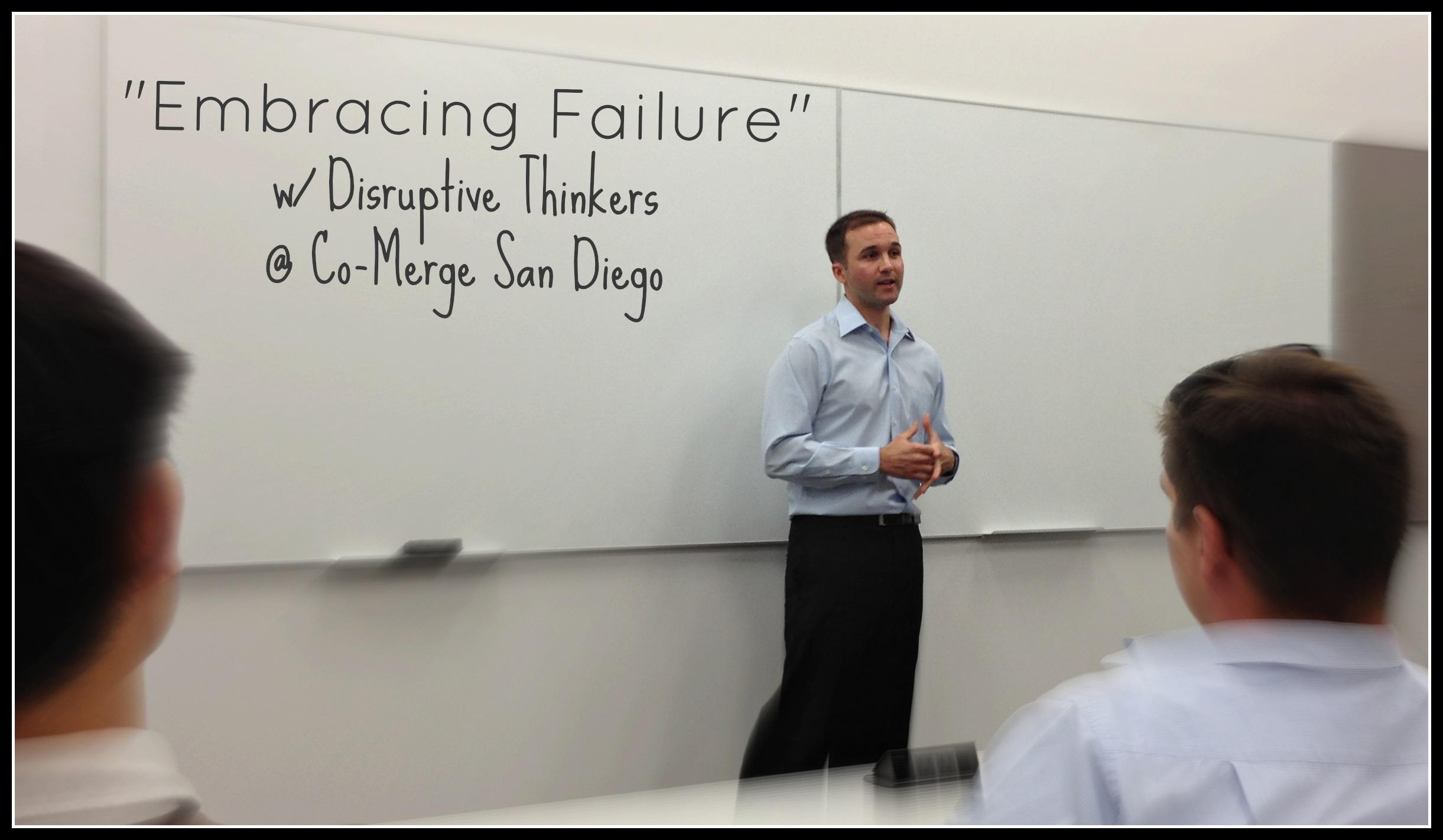
Andrew: I had no idea what podcasting was when I saw John speak at Co-merge. What flipped the switch for me was John’s passion for what he was doing. I was feeling a lack of passion for my job at Target, and I remember part of John’s speech focused on finding what that thing is that you get excited about doing when you wake up in the morning.
Kate: How long after Co-merge until you started focusing on creating your own podcast?
Andrew: After Co-merge, podcasting sort of went into the idea box – I drew out my business plan and a podcast was there, but I didn’t start working on the podcast itself immediately after. But that is when I decided to revamp my site, which I had started back in 2011 when I was experimenting with Internet marketing.
I had tons of ideas for generating traffic, but again, I was working for Target, and I knew I had to focus on paying off my student loans. Having insurance was nice, too. But I knew if I was going to leave Target, then I needed to start taking it seriously.
By the end of July 2013 – not even eight weeks after Co-merge – I had quit my job at Target.
Notice how they all just tried something, and for some it worked quickly, while others had to tweak their ideas more than others. But they all had to do it.
In the next chapter you’ll begin finding your own podcast idea, but first let’s look at specific expert recommendations for how to pick between your passion or a popular industry for your podcast topic.
If you are too busy to read further right now, check out Free Podcast Course!
Should you bring your passion into your podcast? (and what to do if your passion isn’t popular)
Look at this question:

Over the years, John has interviewed many great experts on the podcast. Ramit Sethi comments on this topic in his interview:
“Stop looking for passion. It’s not falling down from the sky. Once you start growing your business and helping people, you will become passionate. When you are waiting for passion, you are being self-centered.”
And he’s not the only one. There is a clear trend among experts, like Ryan Lee pointing out that people often get too emotionally attached to their idea, and that you can’t out-hustle a bad idea no matter how hard you work.
With Tucker Max adding to the point: “Don’t let your arrogance get in the way of a great idea.” WhT he is referring to is a situation where someone came to him with a problem that he ignored, but later built a successful business around.
Like in the question above, let’s dive into picking between a money-maker and your passion. To better understand how to pick, let’s look at why most podcasts aren’t profitable.
If your passion isn’t popular, then you can choose to do it as an outlet for your own enjoyment. But the important part here is to be sure that that is why you do it – not for the money.
Many podcasts aren’t profitable for exactly that reason: they are not meant to be a business. They are meant as a hobby project.
Other podcasts are not profitable because no one cares about the topic expect for the host, or that audience hasn’t been able to even find that particular podcast yet.
The nature of some topics simply ensures that they are more profitable than other topics due to whom they attract.
For example, something in the language learning space might be wildly more popular than a podcast about medical devices on the surface – until you discover that the value of a listener in the language learning space is worth much less. So if you monetize via sponsorships you will command lower rates.
It typically comes down to how important the problem or topic you’re covering is to the audience. Most people don’t deeply care about learning a foreign language and give up after a few months.
If a language learning business offering a $15/month subscription service wants to spend $10,000 sponsoring a podcast, they need to make 667 sales from just that sponsorship alone to make it worthwhile for them.
Whereas if a medical device is sold from one business to another, the buyer might need the device to offer a service to their customers.
Because each device is expensive, each sale is worth, say $100,000. If they can get just one sale from sponsoring a podcast for $10,000, then it is worth it for them.
Now, let’s dive in and find your own podcast topic!
IGNITE and uncover your perfect list of podcast ideas through the Zone of Fire exercise
Before we dive into the technicalities of what works and what doesn’t, let’s start with something fun.
Here at Entrepreneurs on Fire, John wants you to find the “overlap”: where you think your podcast topic is AWESOME, and everyone else thinks so, too.
To find that “overlap”, which John refers to as your Zone of Fire, let’s start with a quick exercise.
Take out a piece of paper and a pen, and draw a line down the middle.
On one side you write down your interests and passions, and on the other your skills or expertise.
Set a timer and spend 15 minutes on each side! Here’s an example of what this might look like:
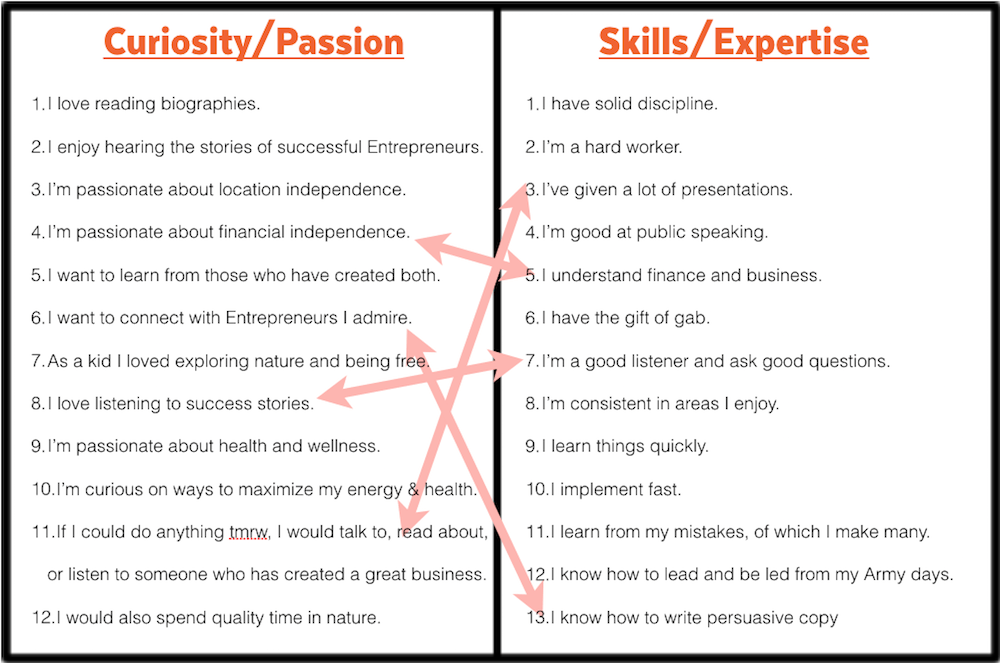
Next draw lines that connect a skill to an interest. Do that with as many as you can – spend 30 minutes.
The overlap you find with your passions and expertise represent your potential Zone of Fire.
Turning your idea into a podcast topic people CAN’T WAIT to listen to
Discover which of your ideas are dead weight in 15 minutes
If you don’t want to monetize your idea, that’s great and you can skip right to the next section: test-driving your idea, where we’ll take an idea and figure out if you are the only one who cares about it.
Next, we want to draw a demand matrix (as Ramit Sethi generously shared with us in his episode on the podcast). This is typically used for business ideas, and we can use the same principles for our podcast idea.
You draw a square and draw a line vertically and horizontally in the middle so you have four boxes.
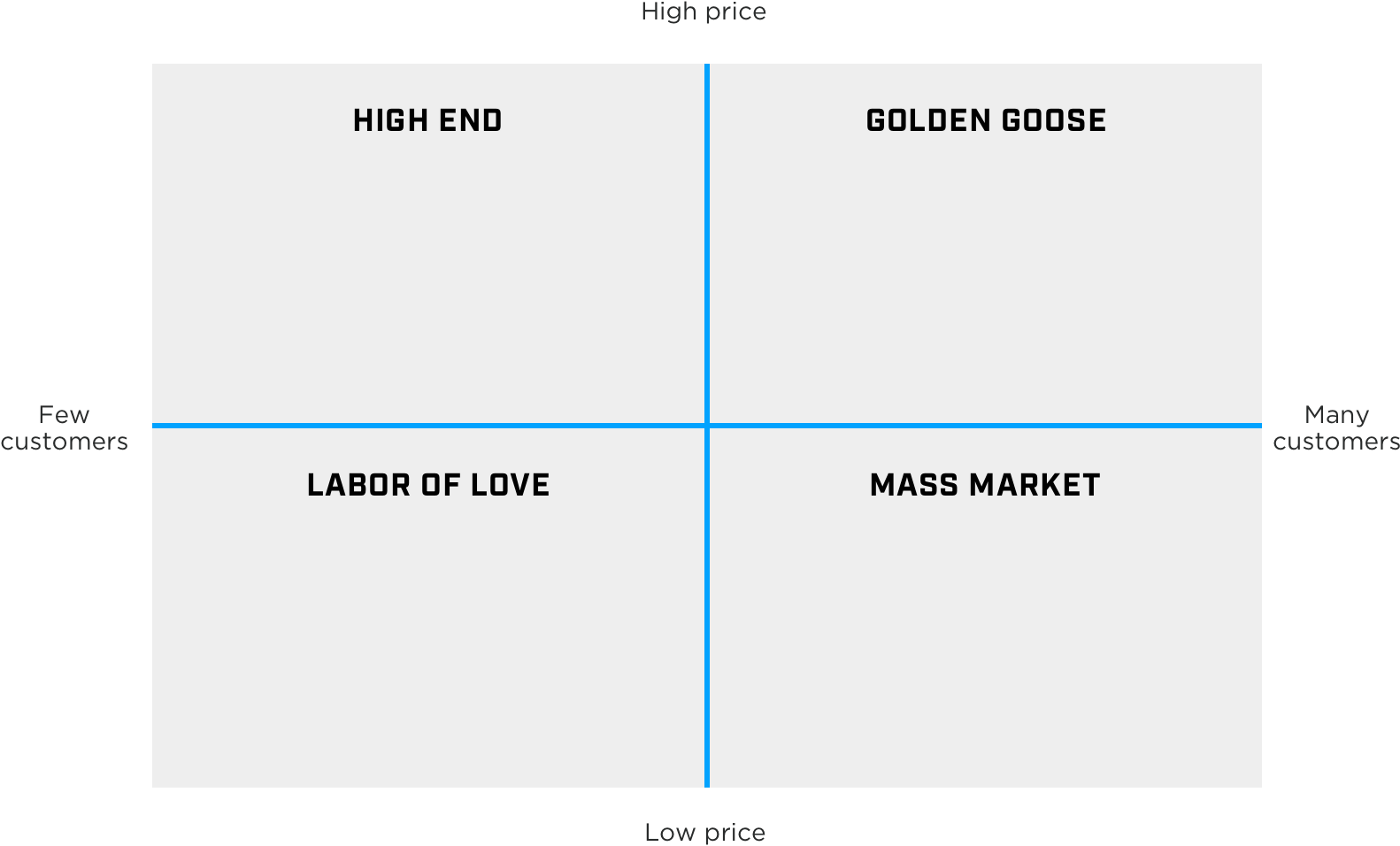
As illustrated above, you write ‘high end’, ‘labor of love’, ‘golden goose’, and ‘mass market’, and plot in where you think each of your ideas fit.
It’s easy to get stuck here, so don’t focus on making this perfect, rather putting it in as you think it fits.
The goal is not to find your winning idea yet, but instead to find the ‘labor of love’ ideas. These are the ideas that are NOT going to work – or at least the ones that are unlikely to be attractive to others.
We can still choose to do them, but understanding this up front will be helpful so we know exactly what we are getting into.
This should take you no more than 15 minutes.
When your perfect idea has already been done
Look at this comment:
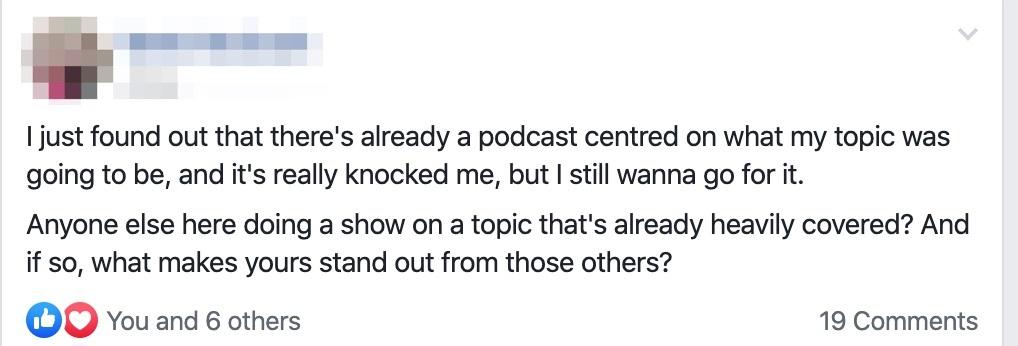
We previously learned that it’s not a good idea to simply wait around for the perfect idea. It’s a romantic vision, and unfortunately doesn’t happen in the classic Entrepreneurs On Fire way.
I’ll give it to you straight in its raw form.
BUT there is a way to analyze our ideas and refine the best ones so they become a hit – all before you record your first podcast episode or even set up a website!
This way you can *virtually* guarantee that it will work. (I say virtually because nothing is guaranteed in this world, but this is pretty close.)
I’m sure you’ve already thought about an idea or two only to discover that someone has already done it. For most of us that is a big downer because then we then have to discard it…
Here on Entrepreneurs On Fire, John believes that is proof of concept!
It is unfortunate that many of us think we need to have a stroke of genius to think up that one amazing idea no one has thought about before.
The thing is, there are so many people around the world nowadays that there are almost no ideas that someone hasn’t thought about. Think of Friendster and Facebook.
It wasn’t that the idea of a social network was unique, but that it was done in a better way by Facebook, which allowed them to conquer the competition.
The important takeaway here is that if you have an idea you are excited about and someone has already done it, that means it works!
What would you rather have: a cool idea that you are the only one who cares about, or an idea you know other people also care about?
We can always tweak the core idea to a slightly different audience, or do something better than what is out there already (e.g. tell more stories, interview more people, or fewer people – or simply do it our way using our personality).
Listeners often like a podcast because of the hosts (your) personality. Not because the idea is unique.
Maybe people have done a podcast on entrepreneurship before, but Entrepreneurs On Fire is different because of John and Kate’s personality and the fact that they published interviews 7 days a week for 2,000 episodes straight!
We need to reframe our thoughts from “then I can’t do it” to “now I know the idea works, I just need to tweak it and create my own twist to it.”
There are no perfect podcast ideas out there. Just podcast ideas that are tested with the audience and tweaked until they enjoy it along with the owner. It is as simple as that.
And in the next chapter we’ll show you exactly how to do just that.
To hammer this point home, let’s look back to when Entrepreneurs On Fire began with John’s former coach Jaime Masters in their interview:
Jaime: One of the interesting things to me is that there were other people before you talking about creating a podcast.
But the thing is that Cliff Ravenscraft was already doing that, Pat Flynn had a free guide on doing that, and then you came along and said ‘I want to teach people how to do this,’ and there were already so many people doing the exact same thing… so why would they listen to you? What made you start and go forward down that route?
John: I think that’s a really important question to address and I’m glad you brought it up. Here you have Cliff Ravenscraft coming out as the ‘Podcast Answer Man’. He’s created a course called ‘Podcasting A-Z’, which is a 4-6 week course, for a couple of thousand dollars, and he hand walks you through it and it’s really powerful.
Then you have Pat Flynn, who’s in Cliff Ravenscraft’s mastermind, and he’s said publicly a number of times ‘I went to Cliff and said I was interested in creating podcasting tutorials because my audience keeps asking about it,’ and Cliff’s response was ‘Well, Pat, you need to do that because your audience wants to learn from you, just like my audience wants to learn from me.’
That lightbulb went off and I realized that Cliff’s audience and Pat’s audience want to learn specifically from them, and my audience wants to learn specifically from me.
So I think it’s really important for people to realize that you are going to have your audience who, even if there is other content out there, are still your audience. They know they can trust you and they want to be under your tutelage, and that’s a really important distinction to make.
Test-drive your podcast idea: go from perfect to profitable
This guy puts it perfectly:

As it turns out, this is a popular question on Pat Flynn’s podcast as well (so popular in fact, that he wrote a book about it). “Lack of proper validation kills more businesses than anything else”.
Our next exercise will help you figure that out.
In the previous exercise, you’ve removed the worst ideas from your Zone of Fire. The next step is for you to test-drive the idea you chose so you can understand if it is likely to get you traction.
A friend of the podcast, Richie Norton, says it best in his interview with John: “Do not keep all your ideas to yourself – share them with others!”
If at any point during this process you realize your idea is not lined up to serve a specific audience and generate revenue – and you’d like to earn money from your podcast – then go back and start over with a new idea.
It’s better to get this right before moving forward or you’ll run into headaches later.
If you already have an audience, you can simply email them to start the conversation. That is the easiest option.
You could start by writing:
“Hi X,
I’m working on 3 podcast ideas – which one are you most interested in? Why?
- Idea 1
- Idea 2
- Idea 3
-Chris”
I suggest that you add some kind of value before, and then end with this so that your ask isn’t the only thing they see in their inbox.
If you don’t have an audience already, then there are a few options you can try. The important part here is doing the one that seems the easiest to you so you don’t procrastinate.
You can find a few Facebook groups and ask people for feedback. This can either be as a Facebook post in a group or in a comment on someone else’s post if it is relevant. However, be considerate so you don’t come across as spammy.
You can do this almost anywhere online, but be mindful of getting feedback from people in the right target audience – not just anyone.
Even though it is uncomfortable for many, you’ll want to get them on the phone to better understand what they think of the idea.
The more people you can get feedback from the better. Ten people is a good place to start. If you’d like other approaches, Kate shares more ideas here in The Fire Path Project.
Trent Dyrsmid says it well in his interview:
“Your first idea is rarely going to end up being successful. It’s the iterative approach of what I call my green dot theory…
So you get into business and you are trying to sell these green dots. But you’re not very successful at it and so the smart entrepreneur, in his or her desire to become a master of selling green dots, discovers that there are blue dots.
There’s a market for blue dots out there and so you shift your strategy a little bit and you start selling blue dots.
You get a little bit more traction and now you kind of forget about green dots – that first idea – because you’ve reiterated.
That process repeats itself and maybe we’re going to go into purple dots, red dots, and yellow dots, and by the time you get to pink dots, you’re like a pink dot selling super-ninja.
So you would have never ever discovered pink dots had you not started by trying to sell green. The best way to succeed in business is to be in business.
If you are thinking about being in business or you have a business plan but you’re not yet in business, you’re not going to have those conversations with your customers, and you’re not going to study your competitor to the degree that you would if you were actually in business – that will lead you to iterate your idea.”
If you are too busy to read further right now, check out Free Podcast Course!
Avoid these three popular podcasting traps
Let’s look at some of the common questions people ask about finding a podcast idea.
“How do I pick between too many ideas?”
The question comes in different shapes and forms:
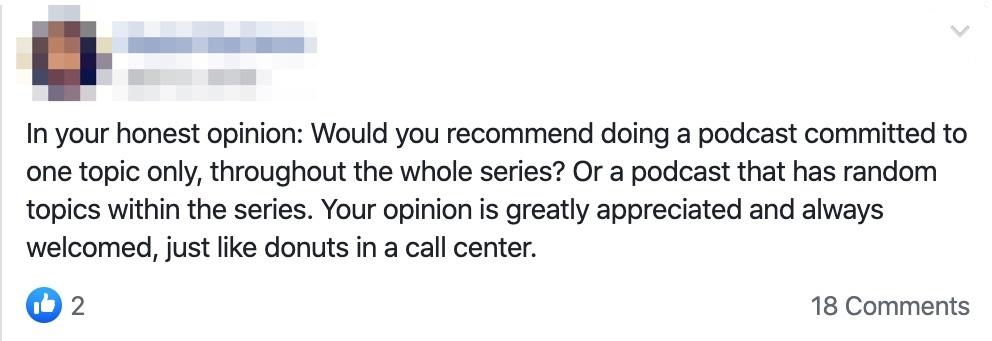
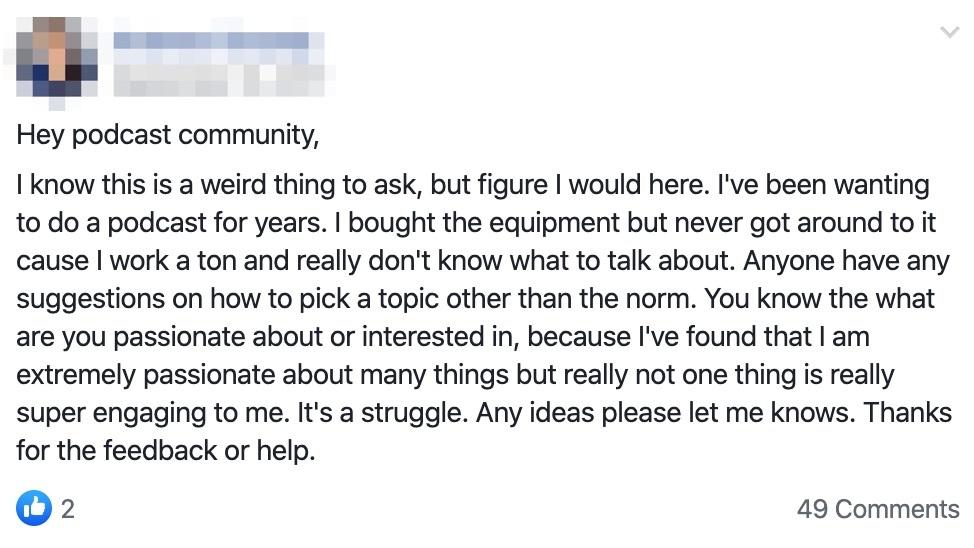
Picking your topic often leads to analysis paralysis where you often feel the need to know all the steps on the journey in order to get started.
Unfortunately, it blocks a lot of smart people from doing awesome things. The reality is that even if you plan it out perfectly, there are still going to be many things you haven’t thought about.
It is impossible to guess if you will be passionate about it until you do it for awhile, so the best way to figure that out is to simply start, (as ugly and imperfect as the production might become). Accept that you will learn as you go.
It’s easier if you even openly tell people (and yourself) that it probably will be terrible at first – like Andrew Warner did in his interview in chapter 1.
“How to niche down and when it is too much or not enough?”
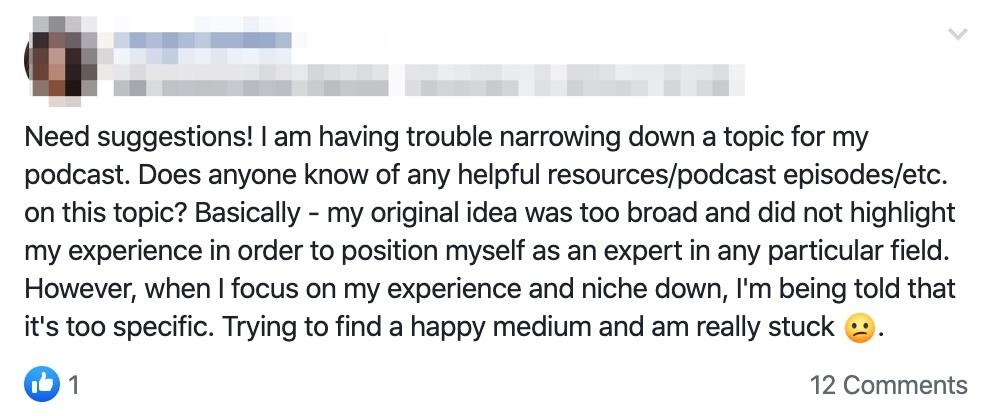
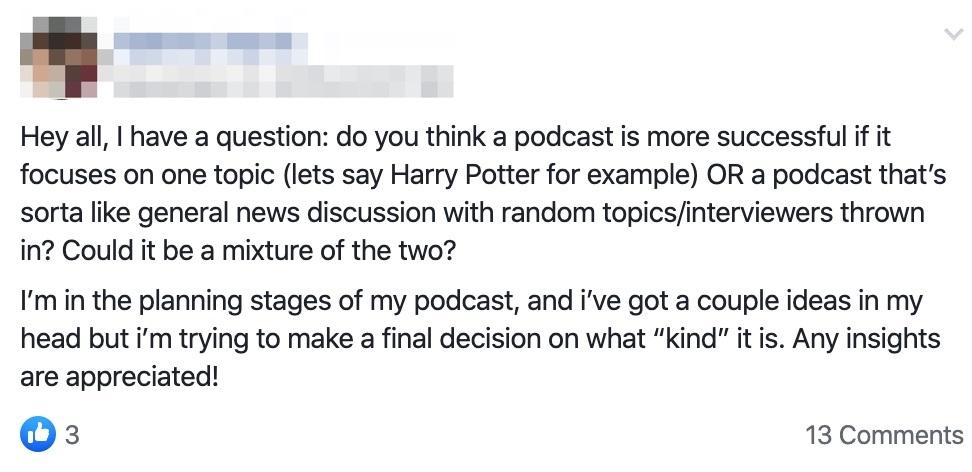
As you uncover our idea it’s tempting to think about scale and how big it can become. Allow me to offer two gold nuggets from successful entrepreneurs:
Meghan Alonso: “Before showing people you can boil the ocean, boil a cup of water first”.
Jim Huffman: “It’s really about focusing on things that matter, or focusing on the right target audience and doing things that maybe don’t scale initially but that add the most value; then, eventually, you’ll figure out how to scale those things.”
This is another example where you want to work your way through the confusion. Ultimately there is no one-size fits all answer, but allow me to offer a piece of perspective. Typically the value comes from the connection you have with your audience. That means if they find it relevant and deep, they will likely listen to many of your episodes.
It makes sense to make it more relevant to a more targeted group of people than to make something for everyone. Think about products that everyone uses: a toothbrush, toilet paper, and washing soap. Not the most exciting things in the world, right?
The more specific you become the more relevance you can create, and thus the more connection you can have with your audience.
It is much easier to do the hard work upfront – like figuring out how to be relevant – and then later grow and expand to a larger audience (e.g. by talking about new topics). It makes it much easier to build early traction for your podcast, which in turn makes it so much more fun to do.
The easiest way to start is by researching what is already out there that is similar, and then creating something that is slightly more specific.
A good benchmark to get started is if you see emotional comments around the topic like those in our research in the previous chapter of this guide.
If you want to get even more specific, Kate offers more advice around narrowing your niche, and also created a comprehensive guide on “How to Start a Podcast: From idea to launch and beyond”.
“Should you do an interview or topic-based podcast?”
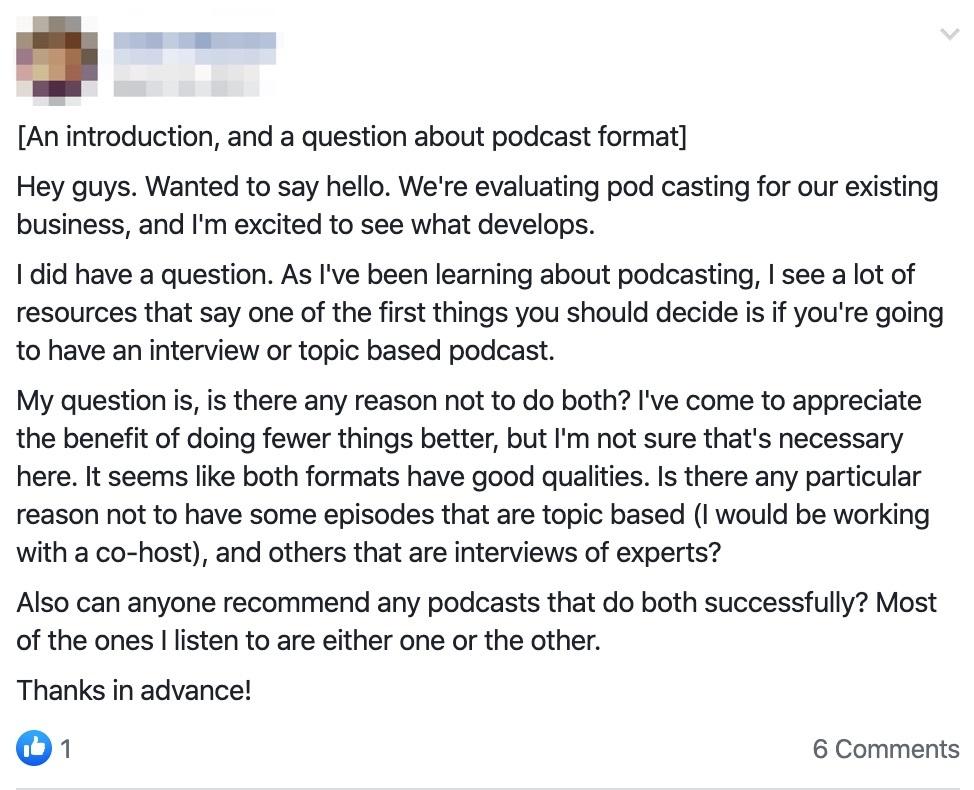
It really depends as Kate points out here. There are really three core questions to ask yourself:
- What would your listener want?
- What type of podcast do YOU want to create?
- Is this going to be valuable content?
And then find an overlap.
23 Podcast ideas to get you started (including 3 you can steal for yourself)
11 obscure podcast ideas that are live right now
- Purely Poop
- Literary Cat Cast
- HVAC School
- Whatever Happened To McDonald’s serving Pizza
- Under The Cross Bones
- The Office Ladies
- The Slutrepreneur Podcast
- Whipcast
- My Dad Wrote A Porno
- The Pez Collection
- Parrot Training Podcast
5 wildly successful podcasts NOT run by a broadcasting network
Entrepreneurs On Fire
The website you are looking at right now has been earning more than $100,000 monthly for over 7 years.
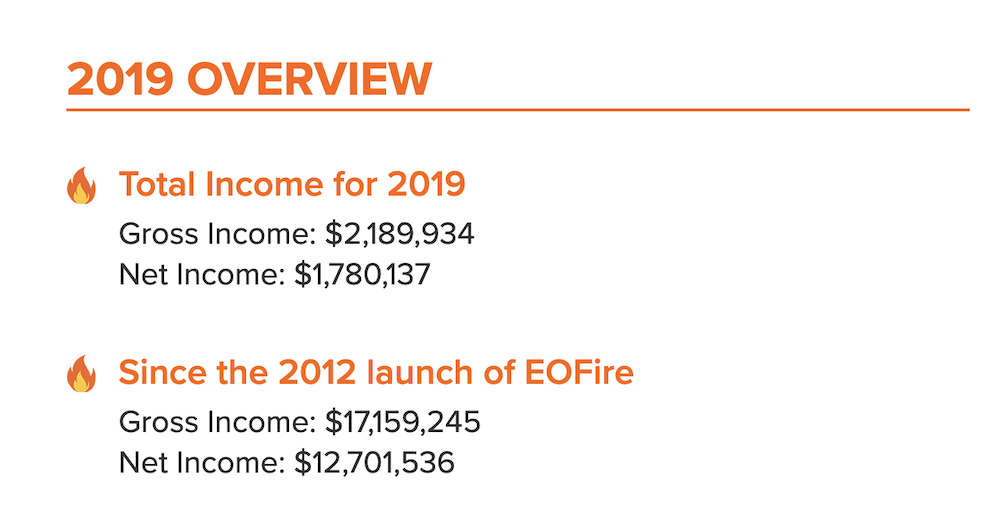
And important to note: their income is generated through a variety of ways – not just one.
That is interesting because it allows the business to sell multiple offers to the same person because they all help with a different need the customer has.
Usually it is much easier to sell to someone who has bought from you in the past and who likes the brand versus someone who has never bought from you before.
You’ve probably heard about the second guy, too, as their work overlaps: Pat Flynn.
Pat Flynn
Pat over at Smart Passive Income actually stopped sharing his income reports in 2018 after having done it for nearly ten years. One of the main reasons he stopped was that beginners felt like he was too far ahead and so he couldn’t help (watch the full explanation video here).
However, you can find all the previous income reports here. And as you’ll be able to see in the his December 2017 income report he shares that he earned $125,819.91 and includes the full breakdown of earnings and expenses.
Another example that is not from the entrepreneurial space, but rather from the social skills arena:
Jordan Harbinger
Jordan has a podcast around social skills earning $480,000 / year (that’s $50k / monthly from in-podcast-ads).
He structured his podcast with a whole team around it, so this is a slightly different model than what many others are doing out there.
Joe Rogan
Joe Rogan’s podcast is likely the biggest podcast out there. At least as a one-person (non-network) podcast.
He also has a bunch of other things going on including MMA and comedy that he funnels traffic to via the podcast. With all that in mind, let’s look at just his podcast and make this even simpler.
Even though his podcast is distributed via many podcast libraries, and he has sponsors on the podcast, let’s only look at what he earns from the ads on his YouTube channel where his podcast is uploaded.
I couldn’t find any trustworthy data displaying exactly how much he earns from the ads, so let’s look at this from a conservative perspective – with an estimate that is most likely on the lower end.
With views per video between 28 million (the Elon Musk episode) and his ‘best of the week’ episodes at a few hundred thousand (say 300,000) views, a fair average is a million views per episode.
CPM (revenue per mille) is referring to how advertisers pay per 1,000 views on an ad (impressions). So one million impressions becomes 1,000 CPM (1,000,000/1,000 = 1,000 CPM).
YouTube takes a 45% cut according to Ad Age – the metric after that is referred to as RPM (revenue per thousand). We don’t know how much he earns per CPM but we do know that CPMs ran at $7.50 on average in Q1 2019 (based on an analysis of 242 million ad impressions).
After a 45% cut for YouTube that becomes $4.125 RPM ($7.55/0.55 = $4.125). To make sure this is a conservative estimate, let’s cut it in half and round down to $2 RPM.
With 1,000 RPM * $2 that is $2,000 per episode. Assuming he publishes on weekdays (20 days/month) then $2,000/episode * 20 days = $40,000/month, which would be $480,000/year.
Tim Ferriss
In this podcast episode (at the [2:12:00]-mark) he mentions that he earns more from the podcast than all his books several fold including his 4x NYT best sellers.
He clarifies that he charged $60 CPM at the time (unlike others, he mentioned that he doesn’t use an agency to help him handle it) and it is important to point out that in this example I am referring to the podcast on his own website – not one that is hosted on a major platform like YouTube, so there appears to be no major cut in his earnings (although it is shared in video format there).
To keep this simple, let’s assume that he is consistent with two ads and 500,000 downloads per episode (his example in the podcast episode above). However, because we are calculating this as CPM, like in the Joe Rogan example above, the 500,000 downloads become 500 CPM (500,000/1,000 = 500 CPM)
The math then becomes: 500(,000) downloads * $60 per CPM * 2 ads = $60,000 per episode.
If he posts once a week with a two week-break throughout the year, that becomes $3 million/year ($60,000 * 50 weeks).
3 Podcast ideas you can steal
Let’s wrap things up with a few ideas you can use to get your brainstorming going full speed ahead!
- A podcast in a pub quiz format
- Crowd-sourced stories from the Internet
- Read unique articles out loud (and give them credit)
Check out Free Podcast Course to create your successful podcast!
Chris writes about freelancing, personal development, online marketing, and business. Get guides like this one to drive results for your own business at freelancingwithchris.com.


